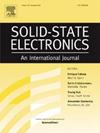Revealing switching statistics and artificial synaptic properties of Bi2S3 memristor
IF 1.4
4区 物理与天体物理
Q3 ENGINEERING, ELECTRICAL & ELECTRONIC
引用次数: 0
Abstract
Complex information processing in neuromorphic systems relies on artificial neurons and synapses as fundamental components. Frequently, memristors are utilized as artificial synapses due to their straightforward configurations, capacity for gradual conductance modulation, and compatibility with high-density integration. The present study reports a novel Ag/Bi2S3/FTO memristor, fabricated using the arrested precipitation technique (APT) based solution processable method. Characterization techniques, including XRD, Raman scattering, and FESEM with EDS, were employed to evaluate the properties of Bi2S3. The device exhibited robust, forming-free, non-volatile resistive switching at low voltages (SET: −0.58 V and RESET: 0.42 V) with an endurance exceeding 6 x 103 cycles and retention times greater than 1.5 x 104 s. Moreover, switching variability was modeled using different statistical distribution techniques. It can mimic learning and forgetting behaviors and different forms of spike-timing-dependent plasticity, akin to its biological counterpart. The trap-filled SCLC mechanism dominated the charge transport in the device. This work introduces new material for investigating low-power consuming electronic devices which holds significant potential for future applications in artificial intelligence electronics and neuromorphic computing systems.

揭示Bi2S3忆阻器的开关统计和人工突触特性
神经形态系统的复杂信息处理依赖于人工神经元和突触作为基本组成部分。由于其简单的结构、逐渐电导调制的能力以及与高密度集成的兼容性,记忆电阻器经常被用作人工突触。本研究报道了一种新型的Ag/Bi2S3/FTO忆阻器,采用基于阻滞沉淀技术(APT)的溶液可加工方法制备。采用XRD、Raman散射、FESEM和EDS等表征技术对Bi2S3的性能进行了评价。该器件在低电压(SET:−0.58 V和RESET: 0.42 V)下表现出稳健、无形成、无挥发的电阻开关,续航时间超过6 × 103次,保持时间大于1.5 × 104 s。此外,使用不同的统计分布技术对开关变异性进行了建模。它可以模仿学习和遗忘行为,以及不同形式的峰值时间依赖的可塑性,类似于它的生物对应物。充满陷阱的SCLC机制主导了器件中的电荷输运。这项工作为研究低功耗电子设备引入了新材料,这些设备在未来的人工智能电子和神经形态计算系统中具有重要的应用潜力。
本文章由计算机程序翻译,如有差异,请以英文原文为准。
求助全文
约1分钟内获得全文
求助全文
来源期刊

Solid-state Electronics
物理-工程:电子与电气
CiteScore
3.00
自引率
5.90%
发文量
212
审稿时长
3 months
期刊介绍:
It is the aim of this journal to bring together in one publication outstanding papers reporting new and original work in the following areas: (1) applications of solid-state physics and technology to electronics and optoelectronics, including theory and device design; (2) optical, electrical, morphological characterization techniques and parameter extraction of devices; (3) fabrication of semiconductor devices, and also device-related materials growth, measurement and evaluation; (4) the physics and modeling of submicron and nanoscale microelectronic and optoelectronic devices, including processing, measurement, and performance evaluation; (5) applications of numerical methods to the modeling and simulation of solid-state devices and processes; and (6) nanoscale electronic and optoelectronic devices, photovoltaics, sensors, and MEMS based on semiconductor and alternative electronic materials; (7) synthesis and electrooptical properties of materials for novel devices.
 求助内容:
求助内容: 应助结果提醒方式:
应助结果提醒方式:


